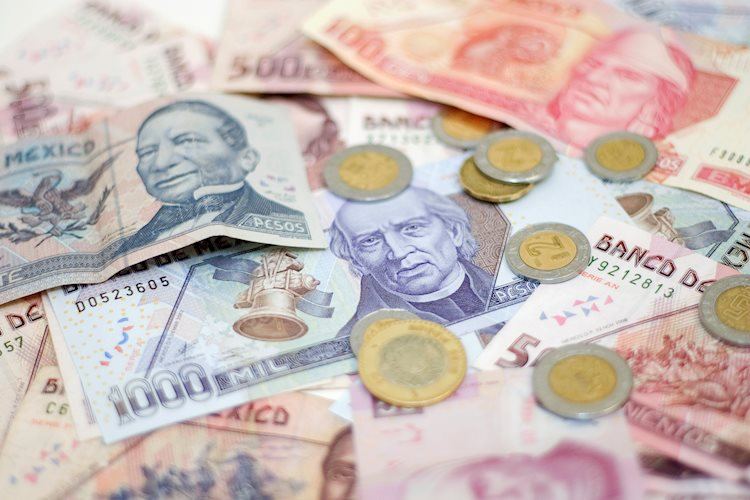- Mexican Peso strengthens further against the US Dollar, as participants estimate Banxico to hold rates unchanged.
- Mexico’s inflation reports a slight decrease, though supports the central bank’s restrictive stance.
- Mixed messages from Federal Reserve officials keep market participants on their toes, as they eye Fed Chairman Jerome Powell’s speech.
Mexican Peso losses traction against the US Dollar in the mid-North American session on Thursday, with traders awaiting the Bank of Mexico’s (Banxico) monetary policy decision. A US 30-year bond auction triggered a jump of more than ten basis points on US Treasury bond yields, consequently, the US Dollar jumped. Therefore, the USD/MXN shifted gears and is almost flat at 17.52, ahead of the Mexican central bank monetary policy decision.
Banxico is expected to keep rates at 11.25% after a report revealed that Mexico’s inflation coming in a tick lower than expected and below previous readings, though the pace of the deflationary process is losing steam. That would refrain Banxico from adopting a dovish posture in its monetary policy statement. Meanwhile, economic data in the United States (US) showed that unemployment claims for the last week fell, indicating strength in the labor market.
Aside from this, Federal Reserve (Fed) officials continued to strike mixed signals, as Philadelphia Fed Patrick Harker emphasized that rates need to remain higher for longer. On the contrary, Chicago’s Fed Goolsbee turned dovish as he saw risks of overshooting rates. Late in the day, Fed Chair Jerome Powell would take the stand at around 19:00 GMT.
Daily digest movers: Mexican Peso remains firm as inflation in Mexico slows down
- Mexico’s Consumer Price Index (CPI) was 4.26% YoY in October, below forecasts of 4.28%, and the previous reading of 4.45%.
- On a monthly basis, inflation rose 0.39%, above the 0.38% consensus and September’s 0.44%.
- Core inflation in Mexico stood high at 5.5% YoY as expected and below September’s data; while prices on a monthly basis ticked up from the 0.39% MoM estimated, above last month’s data and the 0.38% forecast.
- Initial Jobless Claims in the United States for the week ending November 4, rose by 217K, below estimates of 218K, and last week’s 220K.
- USD/MXN gains remain capped even though the American Dollar falls as shown by the US Dollar Index (DXY), a gauge that tracks the buck´s value against a basket of six currencies, retreating 0.05%, down at 105.47.
- Money market futures have priced in a 25 bps rate cut by the Federal Reserve in July 2024.
- Mexico´s economy remains resilient after October’s S&P Global Manufacturing PMI improved to 52.1 from 49.8, and the Gross Domestic Product (GDP) expanded by 3.3% YoY in the third quarter.
- On October 24, Mexico’s National Statistics Agency, INEGI, reported annual headline inflation hit 4.27%, down from 4.45% at the end of September and below forecasts of 4.38%.
- Banxico revised its inflation projections from 3.50% to 3.87% for 2024, which remains above the central bank’s 3.00% target (plus or minus 1%). The next decision will be announced on November 9 at 19:00 GMT
Technical Analysis: Mexican Peso appreciates, though USD/MXN could aim higher as golden cross formation looms
The USD/MXN remains neutrally biased, though about to form a golden cross with the 50-day Simple Moving Average (SMA) crossing above the 200-day SMA, each at 17.67 and 17.68, respectively. That could pave the way for further upside. However, buyers need to lift the exchange rate above the 17.70 area, so they can challenge the 20-day SMA at 17.95, ahead of the psychologically 18.00 figure.
On the flip side, key support levels lie at Monday’s low of 17.40, followed by the 100-day Simple Moving Average (SMA) at 17.32. A breach of the latter will expose the 17.00 figure before the pair aims to test the year-to-date (YTD) low of 16.62.
Inflation FAQs
Inflation measures the rise in the price of a representative basket of goods and services. Headline inflation is usually expressed as a percentage change on a month-on-month (MoM) and year-on-year (YoY) basis. Core inflation excludes more volatile elements such as food and fuel which can fluctuate because of geopolitical and seasonal factors. Core inflation is the figure economists focus on and is the level targeted by central banks, which are mandated to keep inflation at a manageable level, usually around 2%.
The Consumer Price Index (CPI) measures the change in prices of a basket of goods and services over a period of time. It is usually expressed as a percentage change on a month-on-month (MoM) and year-on-year (YoY) basis. Core CPI is the figure targeted by central banks as it excludes volatile food and fuel inputs. When Core CPI rises above 2% it usually results in higher interest rates and vice versa when it falls below 2%. Since higher interest rates are positive for a currency, higher inflation usually results in a stronger currency. The opposite is true when inflation falls.
Although it may seem counter-intuitive, high inflation in a country pushes up the value of its currency and vice versa for lower inflation. This is because the central bank will normally raise interest rates to combat the higher inflation, which attract more global capital inflows from investors looking for a lucrative place to park their money.
Formerly, Gold was the asset investors turned to in times of high inflation because it preserved its value, and whilst investors will often still buy Gold for its safe-haven properties in times of extreme market turmoil, this is not the case most of the time. This is because when inflation is high, central banks will put up interest rates to combat it.
Higher interest rates are negative for Gold because they increase the opportunity-cost of holding Gold vis-a-vis an interest-bearing asset or placing the money in a cash deposit account. On the flipside, lower inflation tends to be positive for Gold as it brings interest rates down, making the bright metal a more viable investment alternative.
